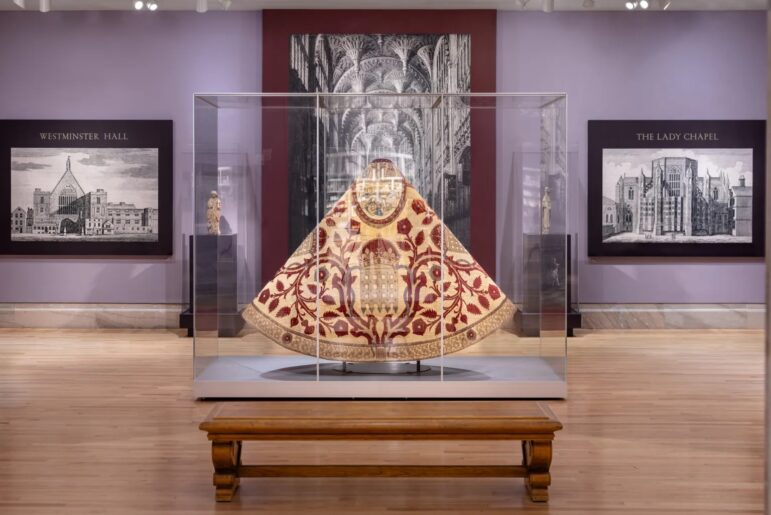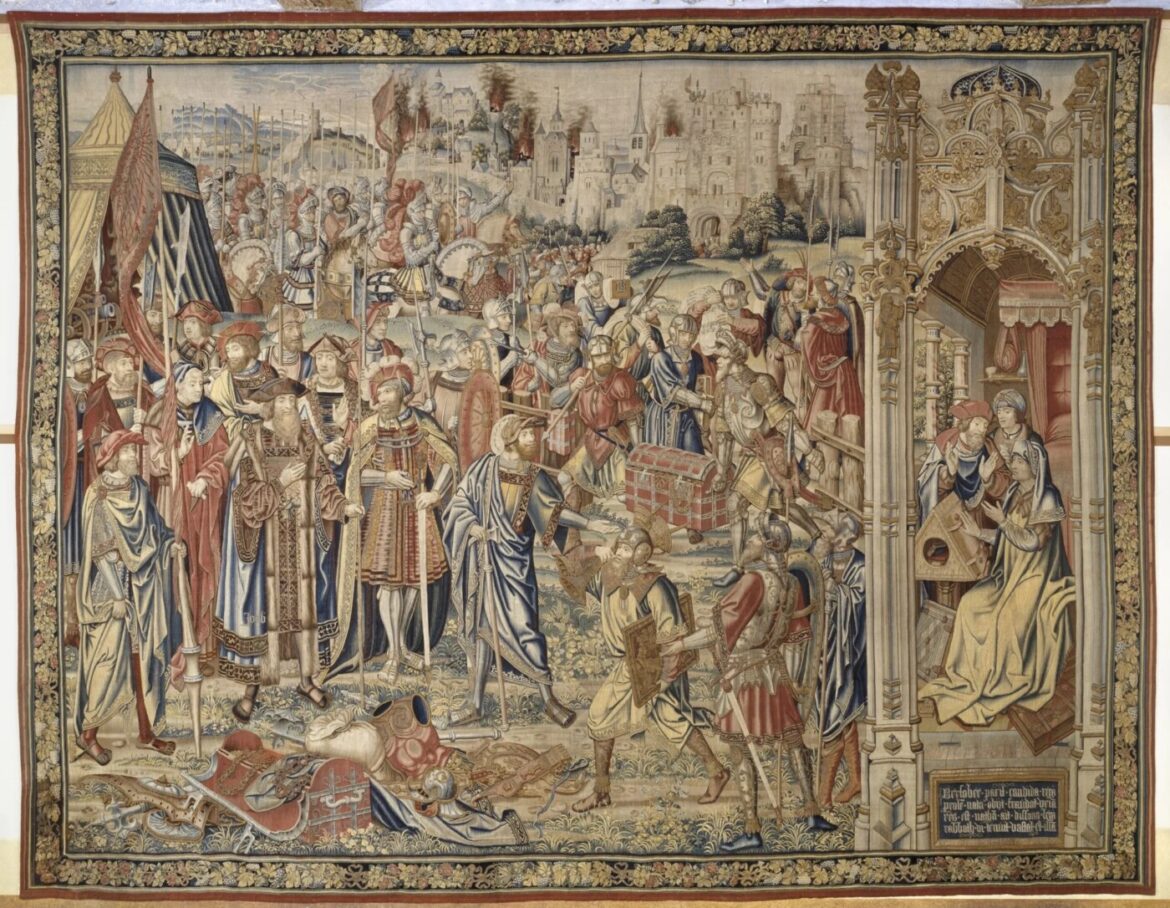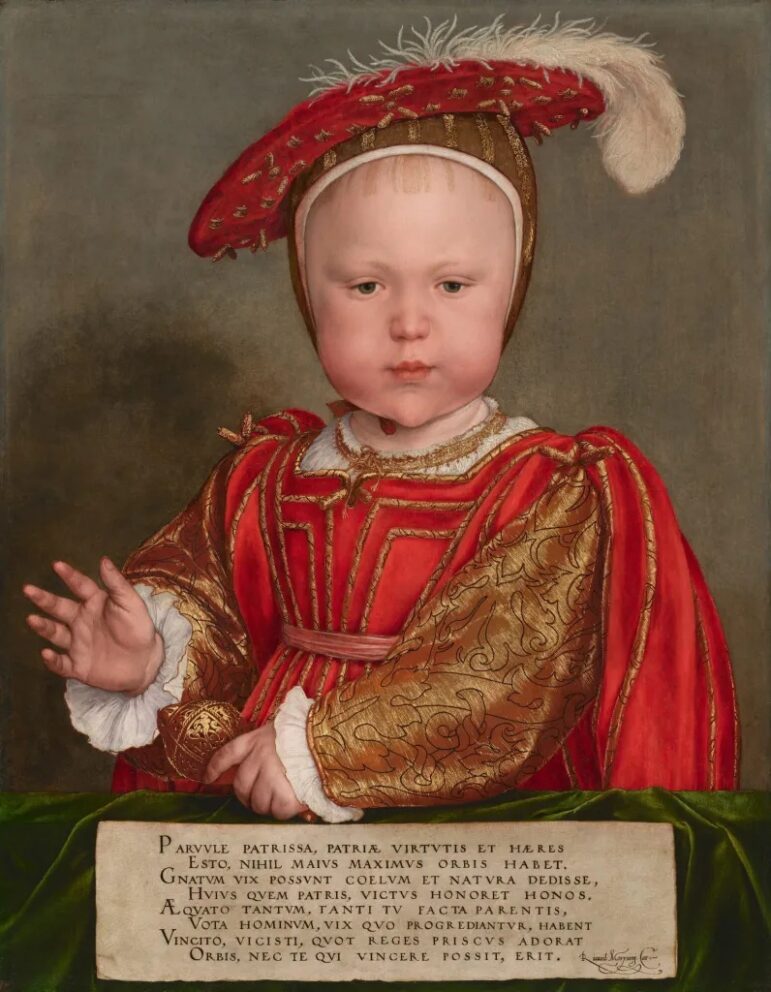The Tudor dynasty ruled England for 118 years, just three generations, but leaving an indelible mark on the country and embodying for many the paradigmatic English monarchy. From Henry VII to Elizabeth I, the Tudors created what Fine Arts Museums of San Francisco Curator in Charge of European Decorative Arts and Sculpture Martin Chapman calls “the theater of royalty,” using beauty and splendor to embody, advertise, and propagandize for their reign.
“The Tudors: Art and Majesty in Renaissance England,” on view at the Legion of Honor in San Francisco through Sept. 24, successfully presents the dramatic history of the Tudors and England of the period with many portraits and splendid objects.
A stunning cape worn by bishops in Westminster Abbey exemplifies Henry VII’s willingness to spend freely on shimmering Italian-made gold velvet capes for 35 bishops that symbolize the king’s power and authority— to both his subjects and foreign rivals.

An intricately carved, heavy dining table known as the “seadog table” (with ornate carvings of the fictional animal at its base) created by a French designer and workmen illustrates the opening of England to European influence on English tastes, artistry and workmanship.
“The Tudors” originated at the Metropolitan Museum of Art in New York. After a stop at the Cleveland Museum of Art, it opened on June 22 in San Francisco as its only West Coast venue. Drawn in large measure from the Met exhibition, it also includes portraits and objects from the Fine Arts Museums’ own collection as well as from international lenders.
The Legion of Honor exhibit is organized chronologically, highlighting the evolution of each monarch.
The Tudors’ reign was marked by world-shaping events. Perhaps most notable was the Reformation, which evolved as a struggle between the Catholic Church and Henry VIII, who separated from it in his desperate effort to produce a male heir to his throne.
On display is the 1540 first English Bible, marking an enormous split from the Vatican, where Latin was the only language and the Pope the only ruler. Henry VIII saw himself as the head of both state and church.
In addition, Henry VIII’s oldest daughter Mary, who ruled for five years, was the first queen of England in her own right, not simply as the wife of a king. Elizabeth, her younger sister, ruled as an unmarried woman for her entire 45-year reign, becoming known as the “virgin queen.”
The England that emerged at the end of the Tudor dynasty was far wealthier and more powerful than that of its predecessor. As they gained world power, the Tudors attracted foreign artists and artisans.
Portraits on view in “The Tudors” played a major part in shaping the public’s perception of the monarchs. The most splendid is the portrait of Henry VIII painted by Hans Holbein the Younger, one of the foremost European portraitists. Henry VIII fills nearly the entire canvas, dressed in robes, furs and jewels that connote luxury and power. The king gazes squarely at his viewer, his majesty undeniable.
So too does his son, Edward VI, who as a child, was painted by Holbein. His costume is more subdued than his father’s, but the feather that curls from his headdress signals a playful royalty, and the bend of his right hand reads as an exercise in future kingship.
In two portraits, Elizabeth is portrayed in all her regal splendor and wielding the power of her office. In a portrait attributed to the English painter George Gower, she embraces symbols of fertility, fitting to a position as a queen seeking a husband. A later portrait of the queen by Nicholas Hilliard shows her as an ageless beauty of iconic status; it replaces paintings of the Virgin Mary that were so prevalent only decades earlier.
Research by museum conservators identified the subject of portrait of an unidentified woman as Frances Walsingham, daughter of the nobleman who was Elizabeth’s “spymaster” for many years.
More portraits show other important players of the period: the Duke of Alençon, an unsuccessful suitor for Elizabeth’s hand; John Fisher, an important advisor to Henry VIII who was beheaded after he refused to recognize the king as the head of the new Church of England; and the Moroccan ambassador to England, with whom the queen joined forces against Spain.
There also is the first known portrait of a Muslim by a European artist, as well as the Heneage Jewel, which has a portrait of Ellizabeth, showing her in profile.
The last portion of the exhibit on the museum’s main floor, and not to be missed, has extremely large tapestries from Henry VII and Henry VIII’s extensive collections exemplifying the splendor of the Tudor court. Worked with exquisite detail, using metallic threads to reflect light, the pieces have Biblical themes: the creation of the world, culminating in the expulsion of Adam and Eve from the Garden of Eden; David, a monarch with whom Henry VIII identified, with Bathsheba; and Saint Paul at a book burning. There’s also a colorful, purely ornamental tapestry with an intricate design in English weaving traditions.
“The Tudors: Art and Majesty in Renaissance England” is on view at the Legion of Honor, 100 34th Ave., San Francisco, through Sept. 24. Admission is $15 (youth) to $30 (general). Visit Legion of Honor (famsf.org).


